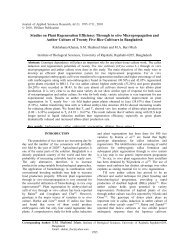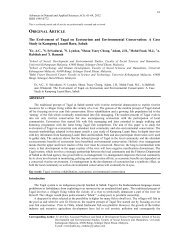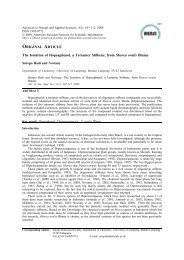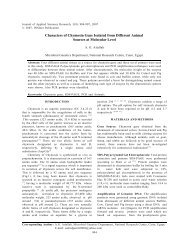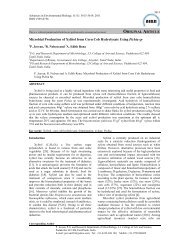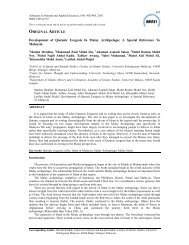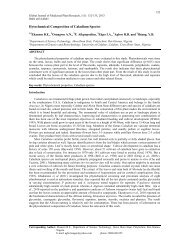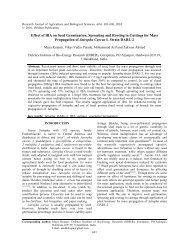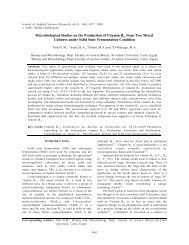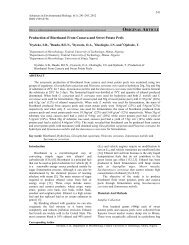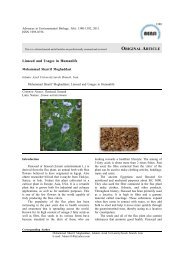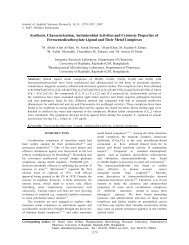ORIGINAL ARTICLE Effect of Medicinal Plants on the ... - aensi
ORIGINAL ARTICLE Effect of Medicinal Plants on the ... - aensi
ORIGINAL ARTICLE Effect of Medicinal Plants on the ... - aensi
You also want an ePaper? Increase the reach of your titles
YUMPU automatically turns print PDFs into web optimized ePapers that Google loves.
Advances in Envir<strong>on</strong>mental Biology, 5(2): 335-344, 2011<br />
ISSN 1995-0756<br />
This is a refereed journal and all articles are pr<str<strong>on</strong>g>of</str<strong>on</strong>g>essi<strong>on</strong>ally screened and reviewed <str<strong>on</strong>g>ORIGINAL</str<strong>on</strong>g> <str<strong>on</strong>g>ARTICLE</str<strong>on</strong>g><br />
<str<strong>on</strong>g>Effect</str<strong>on</strong>g> <str<strong>on</strong>g>of</str<strong>on</strong>g> <str<strong>on</strong>g>Medicinal</str<strong>on</strong>g> <str<strong>on</strong>g>Plants</str<strong>on</strong>g> <strong>on</strong> <strong>the</strong> Mosquito Vectors from <strong>the</strong> Different Agroclimatic<br />
Regi<strong>on</strong>s <str<strong>on</strong>g>of</str<strong>on</strong>g> Tamil Nadu, India.<br />
K. Kovendan* and K. Murugan<br />
Divisi<strong>on</strong> <str<strong>on</strong>g>of</str<strong>on</strong>g> Entomology, Department <str<strong>on</strong>g>of</str<strong>on</strong>g> Zoology, School <str<strong>on</strong>g>of</str<strong>on</strong>g> Life Sciences Bharathiar University, Coimbatore -<br />
641 046, India.<br />
K. Kovendan and K. Murugan; <str<strong>on</strong>g>Effect</str<strong>on</strong>g> <str<strong>on</strong>g>of</str<strong>on</strong>g> <str<strong>on</strong>g>Medicinal</str<strong>on</strong>g> <str<strong>on</strong>g>Plants</str<strong>on</strong>g> <strong>on</strong> <strong>the</strong> Mosquito Vectors from <strong>the</strong> Different<br />
Agroclimatic Regi<strong>on</strong>s <str<strong>on</strong>g>of</str<strong>on</strong>g> Tamil Nadu, India.<br />
ABSTRACT<br />
Vector c<strong>on</strong>trol plays a key role in preventi<strong>on</strong> and c<strong>on</strong>trol <str<strong>on</strong>g>of</str<strong>on</strong>g> major vector-borne infectious diseases in<br />
tropical and subtropical regi<strong>on</strong>s. The three main climatic factors that affect malaria transmissi<strong>on</strong> and distributi<strong>on</strong><br />
are temperature, precipitati<strong>on</strong> and relative humidity. Aedes aegypti, comm<strong>on</strong>ly known as <strong>the</strong> Yellow Fever<br />
Mosquito, is a mosquito that can host <strong>the</strong> dengue fever, Chikungunya and yellow fever viruses. Medically<br />
most important species, Culex quinquefasciatus, breeds in waters polluted with organic debris such as rooting<br />
vegetati<strong>on</strong>, household refuse and excreta. Chemical c<strong>on</strong>trol use <str<strong>on</strong>g>of</str<strong>on</strong>g> pesticides is still <strong>the</strong> most important element<br />
in <strong>the</strong> integrated approach to vector c<strong>on</strong>trol. But <strong>the</strong>y are n<strong>on</strong>-selective and harmful to o<strong>the</strong>r beneficial<br />
organisms. Hence, botanical have grown very important in c<strong>on</strong>trolling <strong>the</strong> mosquito vectors. Laboratory and<br />
field investigati<strong>on</strong>s have been made to evaluate <strong>the</strong> combined effect Clerodendr<strong>on</strong> inerme, Acanthus ilicifolius<br />
<strong>on</strong> three species <str<strong>on</strong>g>of</str<strong>on</strong>g> mosquito vectors, Anopheles stephensi, Aedes aegypti and Culex quinquefasciatus. Different<br />
c<strong>on</strong>centrati<strong>on</strong>s <str<strong>on</strong>g>of</str<strong>on</strong>g> Clerodendr<strong>on</strong> inerme and Acanthus ilicifolius have been tested <strong>on</strong> <strong>the</strong> various stages <str<strong>on</strong>g>of</str<strong>on</strong>g><br />
species <str<strong>on</strong>g>of</str<strong>on</strong>g> mosquito vectors. Lethal c<strong>on</strong>centrati<strong>on</strong>s (LC 50 and LC 90) were also worked for <strong>the</strong> different larval<br />
stages <str<strong>on</strong>g>of</str<strong>on</strong>g> mosquitoes. Significant increased mortality was evident after <strong>the</strong> plant extracts. The lethal effect <strong>on</strong><br />
mosquito larvae may be due to <strong>the</strong> active plant compounds <strong>on</strong> <strong>the</strong> gut lining <str<strong>on</strong>g>of</str<strong>on</strong>g> <strong>the</strong> mosquito larvae. The<br />
larval density was decreased after <strong>the</strong> treatment <str<strong>on</strong>g>of</str<strong>on</strong>g> plant extracts at <strong>the</strong> breeding sites (drinking water and<br />
ditches water), and hence, <strong>the</strong>se plant extracts <str<strong>on</strong>g>of</str<strong>on</strong>g> <strong>the</strong> suitable alternatives <str<strong>on</strong>g>of</str<strong>on</strong>g> syn<strong>the</strong>tic insecticides for <strong>the</strong><br />
mosquito vector management.<br />
Key words: Clerodendr<strong>on</strong> inerme, Acanthus ilicifolius, Anopheles stephensi, Aedes aegypti, Culex<br />
quinquefasciatus, mosquitocidal activity.<br />
Introducti<strong>on</strong><br />
Mosquitoes are <strong>on</strong>e <str<strong>on</strong>g>of</str<strong>on</strong>g> <strong>the</strong> most medically<br />
significant vectors, and <strong>the</strong>y transmit parasites and<br />
pathogens, which c<strong>on</strong>tinue to have devastating impact<br />
<strong>on</strong> human beings. The vector borne diseases caused<br />
by mosquitoes are <strong>on</strong>e <str<strong>on</strong>g>of</str<strong>on</strong>g> <strong>the</strong> major health problems<br />
in many countries. Malaria, Dengue, yellow fever,<br />
filariasis and chikungunya are some <str<strong>on</strong>g>of</str<strong>on</strong>g> <strong>the</strong> deadly<br />
Corresp<strong>on</strong>ding Author<br />
K. Kovendan Divisi<strong>on</strong> <str<strong>on</strong>g>of</str<strong>on</strong>g> Entomology, Department <str<strong>on</strong>g>of</str<strong>on</strong>g> Zoology, School <str<strong>on</strong>g>of</str<strong>on</strong>g> Life Sciences,<br />
Bharathiar University, Coimbatore – 641 046, India<br />
Ph<strong>on</strong>e: +91-9962447932<br />
E-mail: gokulloyo@yahoo.co.in<br />
335<br />
diseases spread by mosquitoes. Anopheles stephensi<br />
is recognized as a major vector for urban malaria in<br />
India. This species prefers to breed in small syn<strong>the</strong>tic<br />
water collecti<strong>on</strong>s and is resp<strong>on</strong>sible for frequent<br />
outbreaks <str<strong>on</strong>g>of</str<strong>on</strong>g> malaria, particularly at c<strong>on</strong>structi<strong>on</strong> sites<br />
in urban areas [14]. Culex quinquefasciatus is<br />
important vector <str<strong>on</strong>g>of</str<strong>on</strong>g> Brancraftian filariasis in tropical<br />
and subtropical regi<strong>on</strong>s. According to WHO[31]about<br />
90 milli<strong>on</strong> people worldwide are infected with
Adv. Envir<strong>on</strong>. Biol., 5(2): 335-344, 2011<br />
Wuchereria bancrafti <strong>the</strong> lymphatic dwelling parstite<br />
and ten times more people ate at <strong>the</strong> risk <str<strong>on</strong>g>of</str<strong>on</strong>g> being<br />
infected. In India al<strong>on</strong>e 25 milli<strong>on</strong> people harbor<br />
micr<str<strong>on</strong>g>of</str<strong>on</strong>g>ilaria (mf) and 19 milli<strong>on</strong> people suffer from<br />
filarial disease manifestati<strong>on</strong>s [19,13]. Aedes aegypti,<br />
a vector <str<strong>on</strong>g>of</str<strong>on</strong>g> dengue, is widely distributed in <strong>the</strong><br />
tropical and subtropical z<strong>on</strong>es. About two-thirds <str<strong>on</strong>g>of</str<strong>on</strong>g><br />
<strong>the</strong> world’s populati<strong>on</strong> lives in areas infested with<br />
dengue vectors. Dengue haemorragic fever occurs in<br />
Asia, <strong>the</strong> Americas and some Pacific islands. Dengue<br />
is endemic in all c<strong>on</strong>tinents except Europe, and<br />
epidemic Dengue viruses, causative agents <str<strong>on</strong>g>of</str<strong>on</strong>g> dengue<br />
fever and more severe dengue haemorragic<br />
fever/dengue shock syndrome, infect over 100 milli<strong>on</strong><br />
people every year [8].<br />
Over 2000 extracts <str<strong>on</strong>g>of</str<strong>on</strong>g> higher plants prepared<br />
from 325 different plant species were screened for<br />
insecticidal activity against <strong>the</strong> larvae <str<strong>on</strong>g>of</str<strong>on</strong>g> A. aegypti.<br />
There are a good number <str<strong>on</strong>g>of</str<strong>on</strong>g> reports <strong>on</strong> <strong>the</strong> successful<br />
use <str<strong>on</strong>g>of</str<strong>on</strong>g> neem and its byproducts against mosquitoes.<br />
Clerodendr<strong>on</strong> inerme Gaertn. (Verbinaceae),<br />
comm<strong>on</strong>ly known as Kashmir bouquet is a biennial,<br />
hardy plant and widely grown as a hedge plant al<strong>on</strong>g<br />
home gardens. The leaf extract <str<strong>on</strong>g>of</str<strong>on</strong>g> <strong>the</strong> plant has been<br />
shown to c<strong>on</strong>tain insecticidal properties against<br />
mosquitoes [9]. Review <str<strong>on</strong>g>of</str<strong>on</strong>g> <strong>the</strong> literature revealed that<br />
various solvent extracts <str<strong>on</strong>g>of</str<strong>on</strong>g> plant materials have been<br />
tested against mosquitoes. Therefore, it was thought<br />
rewarding to investigate <strong>the</strong> dry powder <str<strong>on</strong>g>of</str<strong>on</strong>g> leaf<br />
material as source <str<strong>on</strong>g>of</str<strong>on</strong>g> insecticidal properties against<br />
<strong>the</strong> mosquito larvae. Acanthus ilicifolius Linn.<br />
(Acanthaceae) is relatively lesser-known, yet<br />
important medicinal plant <str<strong>on</strong>g>of</str<strong>on</strong>g> Herbal Material Medica.<br />
The plant is used in traditi<strong>on</strong>al systems <str<strong>on</strong>g>of</str<strong>on</strong>g> medicine,<br />
including Traditi<strong>on</strong>al Indian Medicine (TIM) or<br />
Ayurveda and Traditi<strong>on</strong>al Chinese Medicine (TCM)<br />
[5]. A. ilicifolius (sea holly) occurs in tropical Asia<br />
and Africa, through Malaya to Polynesia. It is a viny<br />
shrub or tall herb, upto 1.5 m high, scarcely woody,<br />
bushy, with very dense growth. Shallow tap roots,<br />
but occasi<strong>on</strong>ally stilt roots are c<strong>on</strong>spicuous. Leaf<br />
simple opposite, decussate, cauline, exstipulate,<br />
petiole short, flattened, glabrous, pulvinous to<br />
sheathing base Flower bisexual, typically<br />
zygomorphic, complete, erect, sessile, hypogynous.<br />
Fruit 1 cm green and 2.5 - 2.0 cm l<strong>on</strong>g, kidney<br />
shaped 4 seed drupe, Seed 0.5 - 1.0 cm l<strong>on</strong>g [32].<br />
This species is found from intermediate to<br />
upstream estuarine z<strong>on</strong>es in <strong>the</strong> mid to high intertidal<br />
regi<strong>on</strong>s. It is shade tolerant with a maximum pore<br />
water salinity <str<strong>on</strong>g>of</str<strong>on</strong>g> 65ppt and a salinity <str<strong>on</strong>g>of</str<strong>on</strong>g> optimal<br />
growth <str<strong>on</strong>g>of</str<strong>on</strong>g> 8ppt [21]. It is found <strong>on</strong> all soil types,<br />
especially muddy areas al<strong>on</strong>g inertial banks. This<br />
species leaves tend to be less spiney in deeper shade<br />
and also <strong>on</strong> <strong>the</strong> older leaves and is <str<strong>on</strong>g>of</str<strong>on</strong>g>ten sympatric<br />
with Acanthus bracteates. This species is a low<br />
sprawling shrub let ranging from 50-120cm tall. It<br />
naturally reproduces vegetatively and also by seeds.<br />
336<br />
Due to this, generati<strong>on</strong> length is difficult to<br />
determine for this species.<br />
Thangam and Kathiresan, [25] Insecticides <str<strong>on</strong>g>of</str<strong>on</strong>g><br />
plant origin have been receiving attenti<strong>on</strong> in recent<br />
years to overcome <strong>the</strong> envir<strong>on</strong>mental hazards in using<br />
syn<strong>the</strong>tic insecticides. Large numbers <str<strong>on</strong>g>of</str<strong>on</strong>g> plant<br />
samples have been screened for <strong>the</strong>ir insecticidal<br />
and/or repellent activities and a few <str<strong>on</strong>g>of</str<strong>on</strong>g> <strong>the</strong>m have<br />
been found promising and <strong>the</strong>ir products are<br />
commercially available. They have investigated for<br />
<strong>the</strong> first time seaweeds, seagrasses and mangrove<br />
plants for <strong>the</strong>ir larvicidal, skin and smoke repellent<br />
activities against mosquito species. Some <str<strong>on</strong>g>of</str<strong>on</strong>g> <strong>the</strong>m<br />
were effective in killing <strong>the</strong> larvae or repelling adult<br />
female mosquitoes. Leaves <str<strong>on</strong>g>of</str<strong>on</strong>g> Escoecaria agalloclla<br />
and Acantllus iliciJolius were found to show smoke<br />
repellent activity. Isolati<strong>on</strong> and identificati<strong>on</strong> <str<strong>on</strong>g>of</str<strong>on</strong>g> active<br />
compounds from <strong>the</strong> effective samples would be<br />
useful in syn<strong>the</strong>sising mosquito larvicides or<br />
repellents <strong>on</strong> a large scale.<br />
In <strong>the</strong> present investigati<strong>on</strong>, we have examined<br />
<strong>the</strong> effect <str<strong>on</strong>g>of</str<strong>on</strong>g> sundried leaf powder <str<strong>on</strong>g>of</str<strong>on</strong>g> Clerodendr<strong>on</strong><br />
inerme and Acantllus iliciJolius against mosquitocidal<br />
activity <str<strong>on</strong>g>of</str<strong>on</strong>g> Anopheles stephensi, Aedes aegypti, Culex<br />
quinquefasciatus.<br />
Materials and Methods<br />
Col<strong>on</strong>izati<strong>on</strong> <str<strong>on</strong>g>of</str<strong>on</strong>g> mosquito vectors<br />
Collecti<strong>on</strong> <str<strong>on</strong>g>of</str<strong>on</strong>g> eggs<br />
The eggs <str<strong>on</strong>g>of</str<strong>on</strong>g> Anopheles stephensi, Aedes aegypti<br />
and Culex quinquefasciatus were collected from local<br />
(in and around Coimbatore, India) different breeding<br />
habitats with <strong>the</strong> help <str<strong>on</strong>g>of</str<strong>on</strong>g> a ‘O’ type brush. The eggs<br />
were <strong>the</strong>n brought to <strong>the</strong> laboratory and transferred<br />
to 18 x 13 x 4 cm size enamel trays c<strong>on</strong>taining 500<br />
ml water and kept for larval hatching.<br />
Maintenance <str<strong>on</strong>g>of</str<strong>on</strong>g> Larvae<br />
The freshly hatched larvae were fed with dog<br />
biscuits and yeast at 60:40 ratios. The feeding was<br />
c<strong>on</strong>tinued till <strong>the</strong> larvae transformed into <strong>the</strong> pupal<br />
stage.<br />
Maintenance <str<strong>on</strong>g>of</str<strong>on</strong>g> pupae and adult<br />
The pupae were collected from culture trays and<br />
were transferred to glass beakers c<strong>on</strong>taining 500 ml<br />
<str<strong>on</strong>g>of</str<strong>on</strong>g> water with help <str<strong>on</strong>g>of</str<strong>on</strong>g> a sucker. The glass beaker<br />
c<strong>on</strong>taining pupae were <strong>the</strong>n kept in 90 x 90 x 90 cm<br />
size mosquito cage for adult emergence.<br />
The cage was made up <str<strong>on</strong>g>of</str<strong>on</strong>g> wooden frames and<br />
covered with poly<strong>the</strong>ne sheets <strong>on</strong> four sides (two<br />
laterals, <strong>on</strong>e back and o<strong>the</strong>r <strong>on</strong>e upper) and <strong>the</strong> fr<strong>on</strong>t<br />
part was covered with a muslin cloth. The bottom <str<strong>on</strong>g>of</str<strong>on</strong>g>
Adv. Envir<strong>on</strong>. Biol., 5(2): 335-344, 2011<br />
<strong>the</strong> cage was fitted with str<strong>on</strong>g cardboard. The<br />
freshly emerged adults were maintained at 27 ± 2°C,<br />
75-85% RH, under 14L: 10D photoperiod cycles. The<br />
adults were fed with 10% sugar soluti<strong>on</strong> for a period<br />
<str<strong>on</strong>g>of</str<strong>on</strong>g> three days before <strong>the</strong>y were provided an animal<br />
for blood feeding.<br />
Blood feeding <str<strong>on</strong>g>of</str<strong>on</strong>g> adult Anopheles stephensi, Aedes<br />
aegypti and Culex quinquefasciatus and egg laying<br />
The adult female mosquitoes were allowed to<br />
feed <strong>on</strong> <strong>the</strong> blood <str<strong>on</strong>g>of</str<strong>on</strong>g> Rabbit (shaved <strong>on</strong> <strong>the</strong> dorsal<br />
side) for two days, to ensure adequate blood feeding<br />
for five days. After blood feeding, ovitraps were<br />
placed inside <strong>the</strong> cage for <strong>the</strong> adults to lay eggs.<br />
Collecti<strong>on</strong> <str<strong>on</strong>g>of</str<strong>on</strong>g> plant materials<br />
The fresh plants Clerodendr<strong>on</strong> inerme, Acanthus<br />
ilicifolius was collected from in and around<br />
Bharathiar University Campus, Coimbatore, India.<br />
The plants were au<strong>the</strong>ntified at BSI (Botanical<br />
Survey <str<strong>on</strong>g>of</str<strong>on</strong>g> India) and <strong>the</strong> specimens were deposited<br />
at Zoology Department, Bharathiar University,<br />
Coimbatore, Tamil Nadu, India.<br />
Preparati<strong>on</strong> <str<strong>on</strong>g>of</str<strong>on</strong>g> plant extracts<br />
Clerodendr<strong>on</strong> inerme, Acanthus ilicifolius fresh<br />
leaves were washed with tap water and shade dried<br />
at room temperature. An electrical blender powdered<br />
<strong>the</strong> dried plant materials (leaves and seeds). From <strong>the</strong><br />
Observed mortality in treatment - Observed mortality in c<strong>on</strong>trol<br />
Corrected mortality � �100<br />
100 - C<strong>on</strong>trol mortality<br />
Number <str<strong>on</strong>g>of</str<strong>on</strong>g> dead larvae<br />
Percentage mortality � �100<br />
Number <str<strong>on</strong>g>of</str<strong>on</strong>g> larvae introduced<br />
337<br />
powder 200g <str<strong>on</strong>g>of</str<strong>on</strong>g> <strong>the</strong> plant materials were extracted<br />
with 2.5 liters <str<strong>on</strong>g>of</str<strong>on</strong>g> organic solvents <str<strong>on</strong>g>of</str<strong>on</strong>g> methanol for<br />
8h, in a Soxhlet apparatus [27]. The crude plant<br />
extracts were evaporated to dryness in rotary vacuum<br />
evaporator.<br />
Preparati<strong>on</strong> <str<strong>on</strong>g>of</str<strong>on</strong>g> required plant extract c<strong>on</strong>centrati<strong>on</strong><br />
One gram <str<strong>on</strong>g>of</str<strong>on</strong>g> <strong>the</strong> plant residue was dissolved in<br />
100 ml <str<strong>on</strong>g>of</str<strong>on</strong>g> methanol (stock soluti<strong>on</strong>) c<strong>on</strong>sidered as<br />
1% stock soluti<strong>on</strong>. From this stock soluti<strong>on</strong> different<br />
c<strong>on</strong>centrati<strong>on</strong>s were prepared ranging from 2 to 10%,<br />
respectively.<br />
Larval toxicity test <str<strong>on</strong>g>of</str<strong>on</strong>g> plant extract<br />
LC 50, LC 90 were calculated from toxicity data by using probit analysis [7].<br />
Pupal toxicity test <str<strong>on</strong>g>of</str<strong>on</strong>g> plant extract<br />
A laboratory col<strong>on</strong>y <str<strong>on</strong>g>of</str<strong>on</strong>g> Anopheles stephensi,<br />
Aedes aegypti and Culex quinquefasciatus larvae<br />
were used for <strong>the</strong> larvicidal activity. Twenty-five<br />
numbers <str<strong>on</strong>g>of</str<strong>on</strong>g> first, sec<strong>on</strong>d, third and fourth instar<br />
larvae were kept in 500 ml glass beaker c<strong>on</strong>taining<br />
249 ml <str<strong>on</strong>g>of</str<strong>on</strong>g> dechlorinated water and 1ml <str<strong>on</strong>g>of</str<strong>on</strong>g> desired<br />
c<strong>on</strong>centrati<strong>on</strong> <str<strong>on</strong>g>of</str<strong>on</strong>g> plant extracts were added. Larval<br />
food was given for <strong>the</strong> test larvae. At each tested<br />
c<strong>on</strong>centrati<strong>on</strong> 2 to 5 trials were made and each trial<br />
c<strong>on</strong>sists <str<strong>on</strong>g>of</str<strong>on</strong>g> three replicates. The c<strong>on</strong>trol was setup by<br />
mixing 1ml <str<strong>on</strong>g>of</str<strong>on</strong>g> acet<strong>on</strong>e with 249 ml <str<strong>on</strong>g>of</str<strong>on</strong>g> dechlorinated<br />
water. The larvae exposed to dechlorinated water<br />
without acet<strong>on</strong>e served as c<strong>on</strong>trol. The c<strong>on</strong>trol<br />
mortalities were corrected by using Abbott’s formula<br />
[1].<br />
A laboratory col<strong>on</strong>y <str<strong>on</strong>g>of</str<strong>on</strong>g> Anopheles stephensi, Aedes aegypti, Culex quinquefasciatus pupae were used for<br />
pupicidal activity. Twenty numbers <str<strong>on</strong>g>of</str<strong>on</strong>g> freshly emerged pupae were kept in 500 ml glass beaker c<strong>on</strong>taining 249<br />
ml <str<strong>on</strong>g>of</str<strong>on</strong>g> dechlorinated water and 1ml <str<strong>on</strong>g>of</str<strong>on</strong>g> desired plant extract c<strong>on</strong>centrati<strong>on</strong>s was added. Five replicates were setup<br />
for each c<strong>on</strong>centrati<strong>on</strong> and c<strong>on</strong>trol was setup by mixing 1ml <str<strong>on</strong>g>of</str<strong>on</strong>g> acet<strong>on</strong>e with 249ml <str<strong>on</strong>g>of</str<strong>on</strong>g> dechlorinated water.<br />
The c<strong>on</strong>trol mortality was corrected by Abbott’s formula [1].<br />
Observed mortality in treatment - Observed mortality in c<strong>on</strong>trol<br />
Corrected mortality � �100<br />
100 - C<strong>on</strong>trol mortality<br />
Number <str<strong>on</strong>g>of</str<strong>on</strong>g> dead pupae<br />
Percentage mortality 100<br />
Number <str<strong>on</strong>g>of</str<strong>on</strong>g> pupae introduced X<br />
�<br />
LC 50, LC 90 were calculated from toxicity data by using probit analysis [7].
Adv. Envir<strong>on</strong>. Biol., 5(2): 335-344, 2011<br />
Field trail<br />
For <strong>the</strong> field trial <strong>the</strong> quantity <str<strong>on</strong>g>of</str<strong>on</strong>g> plant residues<br />
required (Based <strong>on</strong> laboratory LC 90 values) for each<br />
treatment was determined by calculating <strong>the</strong> total<br />
surface area <str<strong>on</strong>g>of</str<strong>on</strong>g> <strong>the</strong> water in each habitat. The<br />
required quantities <str<strong>on</strong>g>of</str<strong>on</strong>g> Clerodendr<strong>on</strong> inerme, Acanthus<br />
ilicifolius were mixed thoroughly with water in a<br />
bucket with c<strong>on</strong>stant agitati<strong>on</strong>. Teepol was used as<br />
emulsifying agent (0.05%). Field applicati<strong>on</strong>s <str<strong>on</strong>g>of</str<strong>on</strong>g> <strong>the</strong><br />
Clerodendr<strong>on</strong> inerme, Acanthus ilicifolius were d<strong>on</strong>e<br />
with <strong>the</strong> help <str<strong>on</strong>g>of</str<strong>on</strong>g> a knapsack sprayer and uniformly<br />
<strong>on</strong> <strong>the</strong> surface <str<strong>on</strong>g>of</str<strong>on</strong>g> <strong>the</strong> water in each habitat. Dipper<br />
sampling and counting <str<strong>on</strong>g>of</str<strong>on</strong>g> larvae m<strong>on</strong>itored <strong>the</strong> larval<br />
density before 24 hrs, 48 hrs and 72 hrs after <strong>the</strong><br />
treatment. A separate sample was taken to determine<br />
<strong>the</strong> species compositi<strong>on</strong> <str<strong>on</strong>g>of</str<strong>on</strong>g> each larval habitat.<br />
Twelve trails were c<strong>on</strong>ducted for Clerodendr<strong>on</strong><br />
inerme, Acanthus ilicifolius al<strong>on</strong>e <strong>the</strong> treatment. The<br />
percentage <str<strong>on</strong>g>of</str<strong>on</strong>g> reducti<strong>on</strong> was calculated by <strong>the</strong><br />
following formula:<br />
=<br />
C�T �100<br />
C<br />
Where,<br />
C – is <strong>the</strong> total number <str<strong>on</strong>g>of</str<strong>on</strong>g> Mosquitoes in c<strong>on</strong>trol<br />
T – is <strong>the</strong> total number <str<strong>on</strong>g>of</str<strong>on</strong>g> Mosquitoes in treatment<br />
Statistical analysis<br />
The average larval mortality data were subjected<br />
to probit analysis for calculating LC 50 and LC 90<br />
values were calculated by using Finney’s Method [7]<br />
SPSS 13.00 versi<strong>on</strong>s were used.<br />
Results<br />
Larval and pupal mortality <str<strong>on</strong>g>of</str<strong>on</strong>g> Anopheles<br />
stephensi after <strong>the</strong> treatment <str<strong>on</strong>g>of</str<strong>on</strong>g> methanolic extract <str<strong>on</strong>g>of</str<strong>on</strong>g><br />
Clerodendr<strong>on</strong> inerme leaf extract is shown in Table<br />
1. 22% mortality was noted at I instar larvae by <strong>the</strong><br />
treatment at 20 ppm whereas it has been increased to<br />
81% at 100 ppm <str<strong>on</strong>g>of</str<strong>on</strong>g> C. inerme leaf extract. The LC 50<br />
and LC 90 values were represented as follows: LC 50<br />
value <str<strong>on</strong>g>of</str<strong>on</strong>g> I instar was 55.042%, II instar was<br />
63.338%, III instar was 73.050% and IV instar was<br />
80.167%. LC 90 value <str<strong>on</strong>g>of</str<strong>on</strong>g> I instar was 125.502%, II<br />
instar was 137.168%, III instar was 153.544% and<br />
IV instar was 156.931%, respectively. The LC 50<br />
value <str<strong>on</strong>g>of</str<strong>on</strong>g> pupae was 74.355% and LC 90 value <str<strong>on</strong>g>of</str<strong>on</strong>g><br />
pupae was 199.206% respectively.<br />
Table 2 illustrates <strong>the</strong> larval and pupal mortality<br />
<str<strong>on</strong>g>of</str<strong>on</strong>g> Aedes aegypti (I to IV instars and pupae) after <strong>the</strong><br />
treatment <str<strong>on</strong>g>of</str<strong>on</strong>g> methanolic extract <str<strong>on</strong>g>of</str<strong>on</strong>g> Clerodendr<strong>on</strong><br />
inerme at different c<strong>on</strong>centrati<strong>on</strong>s (20 to 100 ppm).<br />
30% mortality was noted at I instar larvae by <strong>the</strong><br />
treatment <str<strong>on</strong>g>of</str<strong>on</strong>g> C. inerme at 20 ppm whereas it has<br />
338<br />
been increased to 88% at 100 ppm <str<strong>on</strong>g>of</str<strong>on</strong>g> C. inerme leaf<br />
extract treatment. The LC 50 and LC 90 values were<br />
represented as follows: LC 50 value <str<strong>on</strong>g>of</str<strong>on</strong>g> I instar was<br />
45.749%, II instar was 51.042%, III instar was<br />
57.170% and IV instar was 68.166%, respectively.<br />
LC 90 value <str<strong>on</strong>g>of</str<strong>on</strong>g> I instar was 110.392%, II instar was<br />
116.758%, III instar was 128.697% and IV instar<br />
was 145.587%. The LC 50 value <str<strong>on</strong>g>of</str<strong>on</strong>g> pupae was<br />
56.444% and LC 90 value <str<strong>on</strong>g>of</str<strong>on</strong>g> pupae was 184.556%<br />
respectively.<br />
Table 3 provides <strong>the</strong> c<strong>on</strong>siderable larval and<br />
pupal mortality <str<strong>on</strong>g>of</str<strong>on</strong>g> Culex quinquefasciatus (I to IV<br />
instars) after <strong>the</strong> treatment <str<strong>on</strong>g>of</str<strong>on</strong>g> methanolic extract <str<strong>on</strong>g>of</str<strong>on</strong>g><br />
Clerodendr<strong>on</strong> inerme leaf extract at different<br />
c<strong>on</strong>centrati<strong>on</strong>s (20 to 100 ppm). 40% mortality was<br />
noted at I instar larvae by <strong>the</strong> treatment <str<strong>on</strong>g>of</str<strong>on</strong>g> C. inerme<br />
at 20 ppm whereas it has been increased to 91% at<br />
100 ppm. The LC 50 and LC 90 values were represented<br />
as follows: LC 50 value <str<strong>on</strong>g>of</str<strong>on</strong>g> I instar was 34.767%, II<br />
instar was 39.299%, III instar was 47.311% and IV<br />
instar was 54.395%, respectively. LC 90 value <str<strong>on</strong>g>of</str<strong>on</strong>g> I<br />
instar was 99.894%, II instar was 108.553%, III<br />
instar was 131.860% and IV instar was 150.486%,<br />
respectively. The LC 50 value <str<strong>on</strong>g>of</str<strong>on</strong>g> pupae was 55.100%<br />
and LC 90 value <str<strong>on</strong>g>of</str<strong>on</strong>g> pupae was 190.363% respectively.<br />
Table 4 illustrates <strong>the</strong> larval and pupal mortality<br />
<str<strong>on</strong>g>of</str<strong>on</strong>g> Anopheles stephensi (I to IV instars) after <strong>the</strong><br />
treatment <str<strong>on</strong>g>of</str<strong>on</strong>g> methanolic extract <str<strong>on</strong>g>of</str<strong>on</strong>g> Acanthus ilicifolius<br />
at different c<strong>on</strong>centrati<strong>on</strong>s (20 to 100 ppm). 23%<br />
mortality was noted at I instar larvae by <strong>the</strong><br />
treatment <str<strong>on</strong>g>of</str<strong>on</strong>g> A. ilicifolius at 20 ppm whereas it has<br />
been increased to 89% at 100 ppm <str<strong>on</strong>g>of</str<strong>on</strong>g> A. ilicifolius<br />
leaf extract treatment. LC 50 value <str<strong>on</strong>g>of</str<strong>on</strong>g> I instar was<br />
52.765%, II instar was 57.764%, III instar was<br />
63.368% and IV instar was 70.185%, respectively.<br />
LC 90 value <str<strong>on</strong>g>of</str<strong>on</strong>g> I instar was 108.301%, II instar was<br />
115.835%, III instar was 125.248% and IV instar<br />
was 131.288%, respectively. The LC 50 value <str<strong>on</strong>g>of</str<strong>on</strong>g> pupae<br />
was 62.784% and LC 90 value <str<strong>on</strong>g>of</str<strong>on</strong>g> pupae was<br />
141.035% respectively.<br />
Table 5 provides <strong>the</strong> c<strong>on</strong>siderable larval and<br />
pupal mortality <str<strong>on</strong>g>of</str<strong>on</strong>g> Aedes aegypti (I to IV instars)<br />
after <strong>the</strong> treatment <str<strong>on</strong>g>of</str<strong>on</strong>g> methanolic extract <str<strong>on</strong>g>of</str<strong>on</strong>g> Acanthus<br />
ilicifolius leaf extract at different c<strong>on</strong>centrati<strong>on</strong>s (20<br />
to 100 ppm). 19% mortality was noted at I instar<br />
larvae by <strong>the</strong> treatment <str<strong>on</strong>g>of</str<strong>on</strong>g> A. ilicifolius at 20 ppm<br />
whereas it has been increased to 78% at 100 ppm <str<strong>on</strong>g>of</str<strong>on</strong>g><br />
A. ilicifolius leaf extract treatment. The LC 50 and<br />
LC 90 values were represented as follows: LC 50 value<br />
<str<strong>on</strong>g>of</str<strong>on</strong>g> I instar was 69.579%, II instar was 76.635%, III<br />
instar was 82.692% and IV instar was 88.230%,<br />
respectively. LC 90 value <str<strong>on</strong>g>of</str<strong>on</strong>g> I instar was 131.813%,<br />
II instar was 143.171%, III instar was 150.588% and<br />
IV instar was 155.707%, respectively. The LC 50<br />
value <str<strong>on</strong>g>of</str<strong>on</strong>g> pupae was 87.287% and LC 90 value <str<strong>on</strong>g>of</str<strong>on</strong>g><br />
pupae was 199.466% respectively.<br />
Table 6 illustrates <strong>the</strong> larval and pupal mortality<br />
<str<strong>on</strong>g>of</str<strong>on</strong>g> Culex quinquefasciatus (I to IV instars) after <strong>the</strong>
Adv. Envir<strong>on</strong>. Biol., 5(2): 335-344, 2011<br />
Table 1: Larval and pupal toxicity effect <str<strong>on</strong>g>of</str<strong>on</strong>g> Clerodendr<strong>on</strong>e inerme against <strong>on</strong> malarial vector, Anopheles stephensi<br />
Larval % <str<strong>on</strong>g>of</str<strong>on</strong>g> mortality LC 50 and Regressi<strong>on</strong> 95% C<strong>on</strong>fidence limit Chi- square<br />
and C<strong>on</strong>centrati<strong>on</strong> (ppm) LC 90 (%) equati<strong>on</strong> ------------------------------------- value<br />
pupal ------------------------------------------------------- LCL UCL<br />
stages 20 40 60 80 100 LC 50 LC 90 (%) LC 50LC 90 (%)<br />
I 22 46 55 62 81 55.0425 Y= -1.00114 48.2069 61.401 4.472<br />
125.502 X= 0.01819 111.7097 146.9242<br />
II 18 40 50 59 73 63.3387 Y= -1.09945 56.6562 70.3442 3.148<br />
137.1685 X= 0.01736 121.1242 162.7326<br />
III 14 36 47 51 65 73.0505 Y= -1.16290 56.6799 100.9596 5.654<br />
153.5547 X= 0.01592 117.3448 286.2014<br />
IV 10 30 43 48 60 80.1671 Y= -1.33835 64.2592 113.5892<br />
156.9319 X= 0.01669 120.1046 291.7177 5.925<br />
74.3557 Y= -.76323 63.4073 90.119<br />
Pupa 26 38 47 53 58 199.2067 X=0.01026 159.2947 288.8586 1.119<br />
LCL: 95% <str<strong>on</strong>g>of</str<strong>on</strong>g> Lower C<strong>on</strong>fidence Limit; UCL: 95% <str<strong>on</strong>g>of</str<strong>on</strong>g> Upper C<strong>on</strong>fidence Limit;<br />
Table 2: Larval and pupal toxicity effect <str<strong>on</strong>g>of</str<strong>on</strong>g> Clerodendr<strong>on</strong>e inerme against <strong>on</strong> dengue vector, Aedes aegypti<br />
Larval % <str<strong>on</strong>g>of</str<strong>on</strong>g> mortality LC 50 and Regressi<strong>on</strong> 95% C<strong>on</strong>fidence limit Chi- square<br />
and C<strong>on</strong>centrati<strong>on</strong> (ppm) LC 90 (%) equati<strong>on</strong> ------------------------------------- value<br />
pupal ------------------------------------------------------- LCL UCL<br />
stages 20 40 60 80 100 LC 50 LC 90 (%) LC 50LC 90 (%)<br />
I 30 48 60 72 88 45.7491 Y= -.90697 38.5843 51.7809<br />
110.3928 X= 0.01982 99.3206 126.9239 1.219<br />
II 26 45 56 68 85 51.0428 Y= -.99541 44.3432 57.0188<br />
116.7588 X= 0.01950 104.8303 134.7089 1.467<br />
III 24 40 52 65 78 57.1706 Y= -1.02434 50.4013 63.6637<br />
128.6971 X= 0.01792 114.3078 151.1792 0.305<br />
IV 18 36 46 57 69 68.1664 Y= -1.12836 61.2459 76.0115 1.509<br />
145.5872 X= 0.01655 127.504 175.1563<br />
Pupa 30 48 56 60 63 56.4447 Y= -.56464 43.5133 68.042 3.814<br />
184.5568 X= 0.01000 147.8371 268.2409<br />
LCL: 95% <str<strong>on</strong>g>of</str<strong>on</strong>g> Lower C<strong>on</strong>fidence Limit; UCL: 95% <str<strong>on</strong>g>of</str<strong>on</strong>g> Upper C<strong>on</strong>fidence Limit;<br />
Table 3: Larval and pupal toxicity effect <str<strong>on</strong>g>of</str<strong>on</strong>g> Clerodendr<strong>on</strong>e inereme against <strong>on</strong> filarial vector, Culex quinquefasciatus<br />
Larval % <str<strong>on</strong>g>of</str<strong>on</strong>g> mortality LC 50 and Regressi<strong>on</strong> 95% C<strong>on</strong>fidence limit Chi- square<br />
and C<strong>on</strong>centrati<strong>on</strong> (ppm) LC 90 (%) equati<strong>on</strong> ------------------------------------- value<br />
pupal ------------------------------------------------------- LCL UCL<br />
stages 20 40 60 80 100 LC 50 LC 90 (%) LC 50LC 90 (%)<br />
I 40 52 70 80 91 34.7672 Y= -.68477 25.7896 41.5636<br />
99.8343 X= 0.01970 89.7323 114.9292 100<br />
II 35 50 68 77 86 39.2991 Y= -.72723 30.528 46.0993<br />
108.5534 X= 0.01850 97.0309 126.1946 0.563<br />
III 32 48 59 67 79 47.3119 Y= -.71714 37.921 54.9079<br />
131.8605 X= 0.01516 114.7187 160.8749 0.668<br />
IV 30 45 54 63 72 54.3957 Y= -.72547 44.8255 62.9172<br />
150.4863 X= 0.01334 127.9704 191.6393 0.61<br />
Pupa 34 48 52 60 65 55.1003 Y= -.52205 40.927 67.2586<br />
190.3638 X= 0.00947 150.5368 285.942 1.048<br />
LCL: 95% <str<strong>on</strong>g>of</str<strong>on</strong>g> Lower C<strong>on</strong>fidence Limit; UCL: 95% <str<strong>on</strong>g>of</str<strong>on</strong>g> Upper C<strong>on</strong>fidence Limit;<br />
Table 4: Larval and pupal toxicity effect <str<strong>on</strong>g>of</str<strong>on</strong>g> Acanthus ilicifolius against <strong>on</strong> malarial vector, Anopheles stephensi<br />
Larval % <str<strong>on</strong>g>of</str<strong>on</strong>g> mortality LC 50 and Regressi<strong>on</strong> 95% C<strong>on</strong>fidence limit Chi- square<br />
and C<strong>on</strong>centrati<strong>on</strong> (ppm) LC 90 (%) equati<strong>on</strong> ------------------------------------- value<br />
pupal ------------------------------------------------------- LCL UCL<br />
stages 20 40 60 80 100 LC 50 LC 90 (%) LC 50LC 90 (%)<br />
I 23 39 57 69 89 52.7651 Y= -1.21760 47.2242 57.9124<br />
108.3014 X= 0.02308 98.8274 121.7204 1.736<br />
II 20 37 51 65 85 57.7646 Y= -1.27480 52.2512 63.1504<br />
115.8351 X= 0.02207 105.24 131.1084 1.397<br />
III 18 34 46 60 80 63.3688 Y= -1.31239 57.6952 69.287<br />
125.2488 X= 0.02071 112.9446 143.469 1.235<br />
IV 13 31 39 56 75 70.1859 Y= -1.47206 64.5587 76.5245<br />
131.2886 X= 0.02097 118.3212 150.5541 1.921<br />
Pupa 22 37 50 62 71 62.7845 Y= -1.02825 55.7053 70.171<br />
141.0358 X= 0.01638 123.5903 169.553 0.71<br />
LCL: 95% <str<strong>on</strong>g>of</str<strong>on</strong>g> Lower C<strong>on</strong>fidence Limit; UCL: 95% <str<strong>on</strong>g>of</str<strong>on</strong>g> Upper C<strong>on</strong>fidence Limit;<br />
339
Adv. Envir<strong>on</strong>. Biol., 5(2): 335-344, 2011<br />
Table 5: Larval and pupal toxicity effect <str<strong>on</strong>g>of</str<strong>on</strong>g> Acanthus ilicifolius against <strong>on</strong> dengue vector, Aedes aegypti<br />
Larval % <str<strong>on</strong>g>of</str<strong>on</strong>g> mortality LC 50 and Regressi<strong>on</strong> 95% C<strong>on</strong>fidence limit Chi- square<br />
and C<strong>on</strong>centrati<strong>on</strong> (ppm) LC 90 (%) equati<strong>on</strong> ------------------------------------- value<br />
pupal ------------------------------------------------------- LCL UCL<br />
stages 20 40 60 80 100 LC 50 LC 90 (%) LC 50LC 90 (%)<br />
I 19 25 39 55 78 69.579 Y= -1.43280 63.8659 76.0079<br />
131.8131 X= 0.02059 118.5759 151.5501 3.225<br />
II 15 23 37 51 69 76.6356 Y= -1.47609 70.3272 84.3722<br />
143.1713 X= 0.01926 127.4693 167.4262 0.415<br />
III 12 21 33 48 63 82.6928 Y= -1.56154 75.8609 91.6203<br />
150.5585 X= 0.01888 133.3175 177.6935 0.012<br />
IV 10 17 30 45 58 88.2307 Y= -1.67572 80.9143 98.2329<br />
155.7074 X= 0.01899 137.5281 184.5996 0.17<br />
Pupa 18 31 42 51 50 87.287 Y= -0.99718 76.1473 105.8331<br />
199.4663 X= 0.01142 162.2213 277.3153 3.958<br />
LCL: 95% <str<strong>on</strong>g>of</str<strong>on</strong>g> Lower C<strong>on</strong>fidence Limit; UCL: 95% <str<strong>on</strong>g>of</str<strong>on</strong>g> Upper C<strong>on</strong>fidence Limit;<br />
Table 6: Larval and pupal toxicity effect <str<strong>on</strong>g>of</str<strong>on</strong>g> Acanthus ilicifolius against <strong>on</strong> filarial vector, Culex quinquefasciatus<br />
Larval % <str<strong>on</strong>g>of</str<strong>on</strong>g> mortality LC 50 and Regressi<strong>on</strong> 95% C<strong>on</strong>fidence limit Chi- square<br />
and C<strong>on</strong>centrati<strong>on</strong> (ppm) LC 90 (%) equati<strong>on</strong> ------------------------------------- value<br />
pupal ------------------------------------------------------- LCL UCL<br />
stages 20 40 60 80 100 LC 50 LC 90 (%) LC 50LC 90 (%)<br />
I 33 45 63 72 93 44.1244 Y= - 0.9480 37.3806 49.8068 4.515<br />
103.7729 X= 0.02149 94.0383 117.8928<br />
II 28 41 59 70 85 50.2586 Y=-0.9975 43.6081 56.1545 0.481<br />
114.8283 X= 0.01985 103.3163 132.0051<br />
III 25 38 55 64 79 56.5538 Y= -1.0224 49.8032 62.9771 0.55<br />
127.4368 X= 0.01808 113.3329 149.3748<br />
IV 22 33 51 58 70 65.5576 Y= -1.0572 58.4508 126.6749 1.073<br />
145.0219 X=0.01613 73.3233 175.3045<br />
Pupa 38 45 52 60 66 53.7219 Y= -.48767 38.3099 66.3112 0.02<br />
194.8983 X= 0.00908 152.5323 301.0476<br />
LCL: 95% <str<strong>on</strong>g>of</str<strong>on</strong>g> Lower C<strong>on</strong>fidence Limit; UCL: 95% <str<strong>on</strong>g>of</str<strong>on</strong>g> Upper C<strong>on</strong>fidence Limit;<br />
treatment <str<strong>on</strong>g>of</str<strong>on</strong>g> methanolic extract <str<strong>on</strong>g>of</str<strong>on</strong>g> Acanthus ilicifolius<br />
at different c<strong>on</strong>centrati<strong>on</strong>s (20 to 100 ppm). 33%<br />
mortality was noted at I instar larvae by <strong>the</strong><br />
treatment <str<strong>on</strong>g>of</str<strong>on</strong>g> A. ilicifolius at 20 ppm whereas it has<br />
been increased to 93% at 100 ppm <str<strong>on</strong>g>of</str<strong>on</strong>g> A. ilicifolius<br />
leaf extract treatment. The LC 50 and LC 90 values<br />
were represented as follows: LC 50 value <str<strong>on</strong>g>of</str<strong>on</strong>g> I instar<br />
was 44.124%, II instar was 50.258%, III instar was<br />
56.553% and IV instar was 65.557%, respectively.<br />
LC 90 value <str<strong>on</strong>g>of</str<strong>on</strong>g> I instar was 103.772%, II instar was<br />
114.828%, III instar was 127.436% and IV instar<br />
was 145.021%, respectively. The LC 50 value <str<strong>on</strong>g>of</str<strong>on</strong>g> pupae<br />
was 53.761% and LC 90 value <str<strong>on</strong>g>of</str<strong>on</strong>g> pupae was<br />
194.898% respectively.<br />
Table 7, 8, 9, 10, 11, 12 provides larval<br />
mortality at field after applying methanloic extracts<br />
<str<strong>on</strong>g>of</str<strong>on</strong>g> Clerodendr<strong>on</strong> inerme and Acanthus ilicifolius<br />
extract <strong>on</strong> three species <str<strong>on</strong>g>of</str<strong>on</strong>g> mosquito vectors namely<br />
malarial vector, Anopheles stephensi, dengue vector<br />
Aedes aegypti and filarial vector, Culex<br />
quinquefasciatus. The selected breeding habitats were<br />
Vadavalli, Mettupalayam, Navavoor privu,<br />
Pommanam palayam, Ooty, Mettupalayam (Kallaru),<br />
at our province Tamil Nadu, India. Clerodendr<strong>on</strong><br />
inerme and Acanthus ilicifolius extract were prepared<br />
at required c<strong>on</strong>centrati<strong>on</strong>s and sprayed by using<br />
knapsack sprayer. Bio-efficacy <str<strong>on</strong>g>of</str<strong>on</strong>g> plant extracts have<br />
been noted. The percentage <str<strong>on</strong>g>of</str<strong>on</strong>g> larval reducti<strong>on</strong> was<br />
noticed during 24 hrs, 48 hrs and 72 hrs at <strong>the</strong><br />
breeding sites. There was complete reducti<strong>on</strong> <str<strong>on</strong>g>of</str<strong>on</strong>g><br />
340<br />
larval density was noted after <strong>the</strong> treatment <str<strong>on</strong>g>of</str<strong>on</strong>g> plant<br />
extracts. Similarly, larval reducti<strong>on</strong> was also noted<br />
after <strong>the</strong> treatment <str<strong>on</strong>g>of</str<strong>on</strong>g> plant extract at <strong>the</strong> different<br />
breeding habitats <str<strong>on</strong>g>of</str<strong>on</strong>g> mosquito vectors.<br />
Discussi<strong>on</strong><br />
Malaria is <strong>the</strong> largest single comp<strong>on</strong>ent <str<strong>on</strong>g>of</str<strong>on</strong>g><br />
disease burden; epidemic malaria, in particular,<br />
remains a major public health c<strong>on</strong>cern in tropical<br />
countries. In many developing countries, and<br />
especially in Africa, malaria exacts an enormous toll<br />
in lives, in medical costs, and in days <str<strong>on</strong>g>of</str<strong>on</strong>g> labor lost<br />
[12]. Aedes aegypti, a vector <str<strong>on</strong>g>of</str<strong>on</strong>g> Dengue and Dengue<br />
hemorrhagic fever, which is a widely distributed<br />
tropical and subtropical disease, is now endemic in<br />
more than 100 countries and threatens <strong>the</strong> health <str<strong>on</strong>g>of</str<strong>on</strong>g><br />
approximately 2.5 billi<strong>on</strong> people. Worldwide, around<br />
80 milli<strong>on</strong> people are infected annually at an attack<br />
rate <str<strong>on</strong>g>of</str<strong>on</strong>g> 4% [18]. In recent years, A. aegypti (Diptera:<br />
Culicidae) spread <strong>the</strong> virus <str<strong>on</strong>g>of</str<strong>on</strong>g> chikungunya which<br />
affected <strong>the</strong> southwest Indian Ocean islands in 2005,<br />
spread out to India, and resulted in an <strong>on</strong>going<br />
outbreak that has involved >1.5 milli<strong>on</strong> patients [24].<br />
Culex quinquefasciatus, <strong>the</strong> potential vector <str<strong>on</strong>g>of</str<strong>on</strong>g><br />
bancr<str<strong>on</strong>g>of</str<strong>on</strong>g>tian filariasis is <strong>the</strong> most widely distributed<br />
mosquito in India. It is resp<strong>on</strong>sible for major public<br />
health problem in India with around 31 milli<strong>on</strong><br />
micr<str<strong>on</strong>g>of</str<strong>on</strong>g>ilaraemics, 23 milli<strong>on</strong> cases <str<strong>on</strong>g>of</str<strong>on</strong>g> symptomatic<br />
filariasis, and about 473 milli<strong>on</strong> individuals<br />
potentially at risk <str<strong>on</strong>g>of</str<strong>on</strong>g> infecti<strong>on</strong>[3].
Adv. Envir<strong>on</strong>. Biol., 5(2): 335-344, 2011<br />
Table 7: Field trail by using methanolic extract <str<strong>on</strong>g>of</str<strong>on</strong>g> Clerodendr<strong>on</strong>e inerme <strong>on</strong> malarial vector, Anopheles stephensi<br />
Place : Vadavalli panchayat, Coimbatore<br />
Habitat : Used pot<br />
Size : 2 X 1.5 m<br />
Depth : 1 cm<br />
Species : Anopheles stephensi<br />
Stage : Larvae<br />
Calculati<strong>on</strong> : 0.5x0.5=0.25x4410=11.1<br />
Required C<strong>on</strong>centrati<strong>on</strong> : 55.2<br />
S. No. Larval Density<br />
----------------------------------------------------------------------------------------------------------------<br />
Before Treatment After Treatment<br />
--------------------------------------------------------------------------------<br />
24 hrs 48 hrs 72 hrs<br />
1 35 2 2 --<br />
2 40 8 5 --<br />
3 25 6 3 --<br />
4 18 3 2 --<br />
5 15 4 3 --<br />
6 8 2 1 --<br />
Total 141 25 16 --<br />
Average 23.5 4.2 2.6 --<br />
% Reducti<strong>on</strong> - 82.3% 88.7% 100%<br />
Table 8: Field trail by using methanolic extract <str<strong>on</strong>g>of</str<strong>on</strong>g> Clerodendr<strong>on</strong>e inerme <strong>on</strong> dengue vector, Aedes aegypti.<br />
Place : Mettupalayam<br />
Habitat : Waste Tyers<br />
Size : 20cm (width)<br />
Depth : 10cm<br />
Species : Aedes aegypti<br />
Stage : larval stage<br />
S. No. Larval Density<br />
----------------------------------------------------------------------------------------------------------------<br />
Before Treatment After Treatment<br />
--------------------------------------------------------------------------------<br />
24 hrs 48 hrs 72 hrs<br />
1 98 5 2 -<br />
2 85 6 1 -<br />
3 79 5 1 -<br />
4 91 5 2 -<br />
5 72 5 1 -<br />
6 81 7 2 -<br />
Total 506 33 9 -<br />
Average 84.9 5.5 1.5 -<br />
% Reducti<strong>on</strong> - 93.47% 98.20% 100%<br />
Table 9: Field trail by using methanolic extract <str<strong>on</strong>g>of</str<strong>on</strong>g> Clerodendr<strong>on</strong>e inerme <strong>on</strong> filarial vector, Culex quinquefasciatus<br />
Place : Coimbatore (Navavoor privu)<br />
Habitat : Waste soil tank<br />
Size : 1m (width)<br />
Depth : 10cm<br />
Species : Culex quinquefasciatus<br />
Stage : larval stage<br />
S. No. Larval Density<br />
----------------------------------------------------------------------------------------------------------------<br />
Before Treatment After Treatment<br />
------------------------------------------------------------------------------<br />
24 hrs 48 hrs 72 hrs<br />
1 44 10 - -<br />
2 40 16 - -<br />
3 54 20 16 -<br />
4 56 10 - -<br />
5 60 14 10 -<br />
6 40 10 1 -<br />
Total - 294 80 27<br />
Average - 49 13 4.5<br />
% Reducti<strong>on</strong> - 72.78% 90.81% 100%<br />
341
Adv. Envir<strong>on</strong>. Biol., 5(2): 335-344, 2011<br />
Table 10: Field trail by using methanolic extract <str<strong>on</strong>g>of</str<strong>on</strong>g> Acanthus ilicifolius <strong>on</strong> malarial vector, Anopheles stephensi<br />
Place : Pommanam palayam Vadavalli panchayat, Coimbatore<br />
Habitat : Water Tank<br />
Size : 2 X 1.5 m<br />
Depth : 1 cm<br />
Species : Aedes aegypti<br />
Stage : Larvae<br />
Calculati<strong>on</strong> : 2 X 1.5 = 3 X 1.84 X 10 = 55.2<br />
Required C<strong>on</strong>centrati<strong>on</strong> : 55.2<br />
S. No. Larval Density<br />
-----------------------------------------------------------------------------------------------------------------------<br />
Before Treatment After Treatment<br />
--------------------------------------------------------------------------------<br />
24 hrs 48 hrs 72 hrs<br />
1 128 61 12 --<br />
2 157 49 7 --<br />
3 168 19 13 --<br />
4 189 34 4 --<br />
5 196 26 4 --<br />
6 147 29 6 --<br />
Total 985 218 48 --<br />
Average 164.1 36.30% 8 --<br />
Reducti<strong>on</strong> - 77.80% 95.10% 100%<br />
Table 11: Field trail by using methanolic extract <str<strong>on</strong>g>of</str<strong>on</strong>g> Acanthus ilicifolius <strong>on</strong> dengue vector, Aedes aegypti.<br />
Place : Ooty<br />
Habitat : Tyers<br />
Size : 10cm (width)<br />
Depth : 10cm<br />
Species : Aedes aegypti<br />
Stage : larval stage<br />
S. No. Larval Density<br />
--------------------------------------------------------------------------------------------------------------------<br />
Before Treatment After Treatment<br />
--------------------------------------------------------------------------------<br />
24 hrs 48 hrs 72 hrs<br />
1 32 1 - -<br />
2 41 - - -<br />
3 35 - - -<br />
4 27 - - -<br />
5 18 - - -<br />
6 40 1 - -<br />
Total 193 2 - -<br />
Average 32.2 0.3 - -<br />
% Reducti<strong>on</strong> - 99% 100% 100%<br />
Table 12: Field trail by using methanolic extract <str<strong>on</strong>g>of</str<strong>on</strong>g> Acanthus ilicifolius <strong>on</strong> filarial vector, Culex quinquefasciatus<br />
Place : Mettupalayam(Kallaru)<br />
Habitat : Drainage<br />
Size : 20cm (width)<br />
Depth : 10cm<br />
Species : Culex quinquefasciatus<br />
Stage : larval stage<br />
S. No. Larval Density<br />
----------------------------------------------------------------------------------------------------------------<br />
Before Treatment After Treatment<br />
--------------------------------------------------------------------------------<br />
24 hrs 48 hrs 72 hrs<br />
1 95 9 3 -<br />
2 90 6 - -<br />
3 80 4 - -<br />
4 95 4 2 -<br />
5 75 6 1 -<br />
6 85 14 2 -<br />
Total - 520 43 8<br />
Average - 86.6 7.16 1.3<br />
% Reducti<strong>on</strong> --- 91.73% 98.46% 100%<br />
342
Adv. Envir<strong>on</strong>. Biol., 5(2): 335-344, 2011<br />
Murugan et al., [17] established <strong>the</strong> neem seed<br />
kernel extract possess antipupati<strong>on</strong>al property for<br />
mosquito species. Babu and Murugan [6] investigated<br />
that <strong>the</strong> larvicidal effect <str<strong>on</strong>g>of</str<strong>on</strong>g> resinous exudate from <strong>the</strong><br />
tender leaves <str<strong>on</strong>g>of</str<strong>on</strong>g> Azadirachta indica. Vahitha et al.<br />
studied <strong>the</strong> larvicidal efficacy <str<strong>on</strong>g>of</str<strong>on</strong>g> Pav<strong>on</strong>ia zeylamica<br />
L. and Acacia ferruginea D.C. against Culex<br />
quinquefasciatus Say.<br />
They results clearly suggested that <strong>the</strong> C. inerme<br />
interfered with developmental processes <str<strong>on</strong>g>of</str<strong>on</strong>g> <strong>the</strong> fourth<br />
instar larvae and pupae <str<strong>on</strong>g>of</str<strong>on</strong>g> A. aegypti. In this c<strong>on</strong>text,<br />
<strong>the</strong> observati<strong>on</strong>s that exposure <str<strong>on</strong>g>of</str<strong>on</strong>g> fourth instar<br />
mosquito Culex quinquefasciatus to e<strong>the</strong>r extract <str<strong>on</strong>g>of</str<strong>on</strong>g><br />
C. inerme leaves resulted in death at larval–pupal<br />
molt and pupal–adult eclosi<strong>on</strong> and suggesting<br />
inhibiti<strong>on</strong> <str<strong>on</strong>g>of</str<strong>on</strong>g> <strong>the</strong> moulting process [20] lend fur<strong>the</strong>r<br />
support to our observati<strong>on</strong>s. EI 50 and EPQ 50 were<br />
found to be 40.8 mg and 144.8 mg respectively. In<br />
<strong>the</strong> present study, Clerodendr<strong>on</strong> inerme plant extracts<br />
showed mosquitocidal activity <strong>on</strong> <strong>the</strong> three species <str<strong>on</strong>g>of</str<strong>on</strong>g><br />
mosquito vectors namely malarial vector, Anopheles<br />
stephensi, dengue vector Aedes aegypti and filarial<br />
vector, Culex quinquefasciatus.<br />
There have been numerous reports <strong>on</strong> <strong>the</strong><br />
mosquito larvicidal activity <str<strong>on</strong>g>of</str<strong>on</strong>g> terrestrial plants. Ours<br />
was <strong>the</strong> first study <strong>on</strong> mosquito larvicidal and<br />
repellent activity <str<strong>on</strong>g>of</str<strong>on</strong>g> marine plants [11]. Subsequently<br />
<strong>the</strong> mosquito larvicidal activity <str<strong>on</strong>g>of</str<strong>on</strong>g> seaweeds,<br />
Plocamium telfairiae and Laurencia nipp<strong>on</strong>ica was<br />
reported by [28,29]. Mosquito larvicidal compounds<br />
were also isolated by <strong>the</strong>m. <str<strong>on</strong>g>Effect</str<strong>on</strong>g>ive repellent<br />
compounds, like dimethyl pthalate, available in <strong>the</strong><br />
market are very costly and moreover <strong>the</strong>y can give<br />
protecti<strong>on</strong> <strong>on</strong>ly for a short period <str<strong>on</strong>g>of</str<strong>on</strong>g> <strong>on</strong>e or two<br />
hours [10]. In view <str<strong>on</strong>g>of</str<strong>on</strong>g> <strong>the</strong>se facts, <strong>the</strong> purified active<br />
compounds from <strong>the</strong> most effective samples found in<br />
our studies could -be effective in killing mosquito<br />
larvae or repelling adult female mosquitoes in an<br />
ec<strong>on</strong>omic and safe manner. This finding would be<br />
useful in <strong>the</strong> field <str<strong>on</strong>g>of</str<strong>on</strong>g> mosquito c<strong>on</strong>trol without<br />
polluting <strong>the</strong> envir<strong>on</strong>ment. [26] while Acanthus<br />
ilicifolius was most effective against Ae. Aegypti by<br />
giving 74% <str<strong>on</strong>g>of</str<strong>on</strong>g> protecti<strong>on</strong> [25]. In <strong>the</strong> present study,<br />
Acanthus ilicifolius treatment <str<strong>on</strong>g>of</str<strong>on</strong>g> good larval and<br />
pupicidal activity <str<strong>on</strong>g>of</str<strong>on</strong>g> against three species <str<strong>on</strong>g>of</str<strong>on</strong>g> mosquito<br />
vectors namely malarial vector, Anopheles stephensi,<br />
dengue vector Aedes aegypti and filarial vector,<br />
Culex quinquefasciatus.<br />
Rao et al. [22] reported that <strong>the</strong> field-tested<br />
relatively stable lipid-rich fracti<strong>on</strong>s <str<strong>on</strong>g>of</str<strong>on</strong>g> neem products,<br />
which were as effective as good quality crude neem<br />
products in <strong>the</strong> c<strong>on</strong>trol <str<strong>on</strong>g>of</str<strong>on</strong>g> culicine vectors <str<strong>on</strong>g>of</str<strong>on</strong>g><br />
Japanese encephalitis and produced a slight but<br />
significant reducti<strong>on</strong> in populati<strong>on</strong> <str<strong>on</strong>g>of</str<strong>on</strong>g> anopheline<br />
pupae. In <strong>the</strong> present study, <strong>the</strong> field trials were<br />
c<strong>on</strong>ducted by using Clerodendr<strong>on</strong> inerme and<br />
Acanthus ilicifolius treatment in different habitats <str<strong>on</strong>g>of</str<strong>on</strong>g><br />
three species <str<strong>on</strong>g>of</str<strong>on</strong>g> mosquito vectors namely malarial<br />
343<br />
vector, Anopheles stephensi, dengue vector Aedes<br />
aegypti and filarial vector, Culex quinquefasciatus<br />
(Vadavalli, Mettupalayam, Navavoor privu,<br />
Pommanam palayam, Ooty, Mettupalayam (Kallaru)<br />
in Tamil Nadu, India. The percentage reducti<strong>on</strong> <str<strong>on</strong>g>of</str<strong>on</strong>g><br />
larval mortality also showed <strong>the</strong> variati<strong>on</strong>s am<strong>on</strong>g <strong>the</strong><br />
different breeding habitats <str<strong>on</strong>g>of</str<strong>on</strong>g> mosquito vectors. This<br />
may due to <strong>the</strong> impact <str<strong>on</strong>g>of</str<strong>on</strong>g> geographical distributi<strong>on</strong> <str<strong>on</strong>g>of</str<strong>on</strong>g><br />
A. stephensi, Aedes aegypti, Culex quinquefasciatus<br />
at <strong>the</strong> breeding sites.<br />
The finding <str<strong>on</strong>g>of</str<strong>on</strong>g> <strong>the</strong> present <str<strong>on</strong>g>of</str<strong>on</strong>g> investigati<strong>on</strong><br />
revealed that Clerodendr<strong>on</strong> inerme and Acanthus<br />
ilicifolius good larvicidal and pupicidal activity<br />
against three species <str<strong>on</strong>g>of</str<strong>on</strong>g> mosquito vectors namely<br />
malarial vector, Anopheles stephensi, dengue vector<br />
Aedes aegypti and filarial vector, Culex<br />
quinquefasciatus at different Agro-climatic regi<strong>on</strong>s <str<strong>on</strong>g>of</str<strong>on</strong>g><br />
Tamil Nadu, India. Their mode <str<strong>on</strong>g>of</str<strong>on</strong>g> acti<strong>on</strong> and effect<br />
<strong>on</strong> n<strong>on</strong> target organism are presently under <strong>the</strong><br />
investigati<strong>on</strong>s. These plant extracts showed that has<br />
good effective mosquito c<strong>on</strong>trol properties and also<br />
can act as an eco-friendly, bio-pesticide for fur<strong>the</strong>r<br />
vector c<strong>on</strong>trol programs.<br />
References<br />
1. Abbott, W.S., 1925. A method <str<strong>on</strong>g>of</str<strong>on</strong>g> computing <strong>the</strong><br />
effectiveness <str<strong>on</strong>g>of</str<strong>on</strong>g> insecticides. Journal Ec<strong>on</strong>omic<br />
Entomology, 18: 267-269.<br />
2. Abdul Rahuman, A., G. Geetha, P. Venkatesan<br />
and K. Geetha, 2008. Isolati<strong>on</strong> and Identificati<strong>on</strong><br />
<str<strong>on</strong>g>of</str<strong>on</strong>g> mosquito from Abutil<strong>on</strong> indicum (Linn.)<br />
Sweet. Parasitology Resesearch, 102: 981-988.<br />
3. Agrawal, Lt., V.K. Col, Wg. Sashindran and<br />
V.K. Cdr, 2006. Lymphatic Filariasis in India:<br />
Problems, Challenges and New Initiatives.<br />
MJAFI, 62: 359-362.<br />
4. Aliero, B.L., 2003. Larvaecidal effects <str<strong>on</strong>g>of</str<strong>on</strong>g><br />
aqueous extracts <str<strong>on</strong>g>of</str<strong>on</strong>g> Azadirachta indica (neem)<br />
<strong>on</strong> <strong>the</strong> larvae <str<strong>on</strong>g>of</str<strong>on</strong>g> Anopheles mosquito, African<br />
Journal <str<strong>on</strong>g>of</str<strong>on</strong>g> Biotechnology, 2(9): 325-327.<br />
5. Amritpal Singh, Sanjiv Duggal, Ashish Suttee,<br />
2009. Acanthus ilicifolius linn.-lesser known<br />
medicinal plants with significant pharmacological<br />
activities. Internati<strong>on</strong>al Journal <str<strong>on</strong>g>of</str<strong>on</strong>g> Phytomedicine,<br />
1: 1-3.<br />
6. Babu, R. and K. Murugan, 2000. Larvicidal<br />
effect <str<strong>on</strong>g>of</str<strong>on</strong>g> resinous exudates from <strong>the</strong> tender<br />
leaves <str<strong>on</strong>g>of</str<strong>on</strong>g> Azadirachta indica. Neem Newsletter,<br />
17:1.<br />
7. Finney, D.J., 1971. Probit analysis. Cambridge<br />
University Press L<strong>on</strong>d<strong>on</strong>. pp: 68-78.<br />
8. Hahn, C.S., O.G. French, P. Foley, E.N. Martin<br />
and R.P. Taylor, 2001. Bispecific m<strong>on</strong>ocl<strong>on</strong>al<br />
antibodies mediate binding <str<strong>on</strong>g>of</str<strong>on</strong>g> dengue virus to<br />
erythrocytes in a m<strong>on</strong>key model <str<strong>on</strong>g>of</str<strong>on</strong>g> passive<br />
viremia. Journal <str<strong>on</strong>g>of</str<strong>on</strong>g> Immunology, 66 (2): 1057-<br />
1065.
Adv. Envir<strong>on</strong>. Biol., 5(2): 335-344, 2011<br />
9. Kalyanasundaram, M. and P.K Das, 1985.<br />
Larvicidal and synergistic activity <str<strong>on</strong>g>of</str<strong>on</strong>g> plant<br />
extracts for mosquito c<strong>on</strong>trol. Indian Journal <str<strong>on</strong>g>of</str<strong>on</strong>g><br />
Medical Research, 82: 19–23.<br />
10. Kalyanasundaram, M., D. Amalraj, K.P. Paily,<br />
Nisha George and C.H. Sujatha, 1986. Syn<strong>the</strong>sis<br />
<str<strong>on</strong>g>of</str<strong>on</strong>g> substituted amides for repellency against<br />
mosquitoes. Current Science, 55: 266-268.<br />
11. Kathiresan, K. and T.S Thangam, 1987. Light<br />
induced effects <str<strong>on</strong>g>of</str<strong>on</strong>g> latex <str<strong>on</strong>g>of</str<strong>on</strong>g> Escoecaria agallocha<br />
L. <strong>on</strong> salt marsh mosquito Culex siliens L.<br />
Journal <str<strong>on</strong>g>of</str<strong>on</strong>g> Marine Biology Associati<strong>on</strong>. India 29:<br />
378-380.<br />
12. Lambert, P.H., 2005. Malaria: past and present.<br />
http://nobelprize.org/medicine/<br />
educati<strong>on</strong>al/malaria; [accessed <strong>on</strong> April 24, 2009]<br />
13. Maheswaran, R., S. Sathis and S. Ignacimuthu,<br />
2008. Larvicidal activity <str<strong>on</strong>g>of</str<strong>on</strong>g> Leucus aspera<br />
(Willd.) against <strong>the</strong> larvae <str<strong>on</strong>g>of</str<strong>on</strong>g> Culex<br />
quinquefasciatus Say. and Aedes aegypti.<br />
Internati<strong>on</strong>al Journal <str<strong>on</strong>g>of</str<strong>on</strong>g> Integrative Biology 2(3):<br />
214-217.<br />
14. Mittal, P.K, T. Adak and V.P Sharma, 1995.<br />
Bioefficacy <str<strong>on</strong>g>of</str<strong>on</strong>g> six neem (Azadirachta indica)<br />
products against mosquito larvae. Journal <str<strong>on</strong>g>of</str<strong>on</strong>g><br />
Pesticide Research. 7: 35-39.<br />
15. Mittal, P.K., T. Adak and S.K. Subbarao, 2005.<br />
Inheritance <str<strong>on</strong>g>of</str<strong>on</strong>g> resistance to Bacillus sphaericus<br />
toxins in a laboratory selected strain <str<strong>on</strong>g>of</str<strong>on</strong>g> An.<br />
stephensi (Diptera: Culicidae) and its resp<strong>on</strong>se to<br />
Bacillus thuringiensis var. israelensis. Current<br />
Science, 89: 442–443.<br />
16. Mulla, M.S. and T. Su, 1999. Activity and<br />
biological effects <str<strong>on</strong>g>of</str<strong>on</strong>g> neem products against<br />
arthropods <str<strong>on</strong>g>of</str<strong>on</strong>g> medical and veterinary importance.<br />
Journal American Mosquito C<strong>on</strong>trol Associati<strong>on</strong>,<br />
15: 133-52.<br />
17. Murugan, K., R. Babu, D. Jeyabalan, N.<br />
Senthilkumar and S. Sivaramakrishnan, 1996.<br />
Antipupati<strong>on</strong>al effect <str<strong>on</strong>g>of</str<strong>on</strong>g> neem oil and neem seed<br />
kernel extract against mosquito larvae <str<strong>on</strong>g>of</str<strong>on</strong>g><br />
Anopheles stephensi List<strong>on</strong>. Journal <str<strong>on</strong>g>of</str<strong>on</strong>g><br />
Entomological Research, 20:137–139.<br />
18. M<strong>on</strong>ath, T.P., 1994. Yellow fever and dengue<br />
<strong>the</strong> interacti<strong>on</strong>s <str<strong>on</strong>g>of</str<strong>on</strong>g> virus, vector and host in <strong>the</strong><br />
re-emergence <str<strong>on</strong>g>of</str<strong>on</strong>g> epidemic disease. Semin.<br />
Virology.5: 133-135.<br />
19. NICD., 1990. Proceedings <str<strong>on</strong>g>of</str<strong>on</strong>g> <strong>the</strong> Nati<strong>on</strong>al<br />
Seminar <strong>on</strong> operati<strong>on</strong> research <strong>on</strong> vector c<strong>on</strong>trol<br />
in filariasis. New Delhi.<br />
20. Pereira, J. and K.N. Gurudutt, 1990. Growth<br />
inhibiti<strong>on</strong> <str<strong>on</strong>g>of</str<strong>on</strong>g> Musca domestica L. and Culex<br />
quinquefasciatus (Say) by (levo)-3-epicaryoptin<br />
isolated from leaves <str<strong>on</strong>g>of</str<strong>on</strong>g> Clerodendr<strong>on</strong> inerme<br />
(Gaertn) (Verbenaceae). Journal <str<strong>on</strong>g>of</str<strong>on</strong>g> Chemical<br />
Ecology, 16: 2297–2306.<br />
344<br />
21. Roberts<strong>on</strong>, A.I. and D.M. Al<strong>on</strong>gi, 1992. Tropical<br />
mangrove ecosystems, Coastal and estuarine<br />
series, Bowman, M.J., Barber, R.T., Mooers,<br />
C.N.K., and Raven, J.A., 329, American<br />
Geophysical Uni<strong>on</strong>, Washingt<strong>on</strong>, DC.<br />
22. Rao, D.R., R. Reuben and B.A. Nagasampagi,<br />
1995. Development <str<strong>on</strong>g>of</str<strong>on</strong>g> combined use <str<strong>on</strong>g>of</str<strong>on</strong>g> Neem<br />
(Azadirachta indica) and water management for<br />
<strong>the</strong> c<strong>on</strong>trol <str<strong>on</strong>g>of</str<strong>on</strong>g> culicine mosquitoes in rice fields.<br />
Medical Veterinary Entomology, 9: 25-33.<br />
23. Subram<strong>on</strong>ia Thangam, T. and K. Kathiresan,<br />
1996. Proceedings <str<strong>on</strong>g>of</str<strong>on</strong>g> <strong>the</strong> Sec<strong>on</strong>d Internati<strong>on</strong>al<br />
C<strong>on</strong>ference <strong>on</strong> Urban Pests. K.B. Wildey<br />
(editor). pp: 431-435.<br />
24. Taubitz, W., J.P. Cramer, A. Kapaun, M. Pfeffer,<br />
C. Drosten, G. Dobler, G.D. Burchard and T.<br />
Loscher, 2007. Chikungunya fever in travelers:<br />
clinical presentati<strong>on</strong> and course. Clinical<br />
Infectious Diseases, 45: 508.<br />
25. Thangam, T.S., K. Srinivasan and K. Kathiresan,<br />
1992. Smoke repellency and killing effect <str<strong>on</strong>g>of</str<strong>on</strong>g><br />
mangrove plants against <strong>the</strong> mosquito Aedes<br />
aegypti (Linnaeus). Tropical Biomedicine, 10:<br />
125-128.<br />
26. Thangam, T.S. and K. Kathiresan, 1992b. Smoke<br />
repellency and killing effect <str<strong>on</strong>g>of</str<strong>on</strong>g> marine plants<br />
against Culex quinoquefisciatus. Tropical<br />
Biomedicine, 9: 35-38.<br />
27. Vogel., 1978. Textbook <str<strong>on</strong>g>of</str<strong>on</strong>g> Practical Organic<br />
Chemistry. The English Language Book Society<br />
and L<strong>on</strong>gman, L<strong>on</strong>d<strong>on</strong>, pp:1368.<br />
28. Watanabe, K., K. Umeda and M. Miyakado,<br />
1989a. Isolati<strong>on</strong> and identificati<strong>on</strong> <str<strong>on</strong>g>of</str<strong>on</strong>g> three<br />
insecticidal principles from <strong>the</strong> red alga<br />
Laurencia nipp<strong>on</strong>ica. Yamada. Agricultural<br />
Biological Chemistry, 53: 2513-2515.<br />
29. Watanabe, K., M. Miyakado, N. Oh<strong>on</strong>o, A.<br />
Okada, K. Yanagi and K. Moriguchi, 1989b. A<br />
olyhalogenated insecticidal m<strong>on</strong>oterpene from <strong>the</strong><br />
red alga, Plocamitrm telfairiae. Phytochemistry,<br />
2(8): 77-78.<br />
30. Watanabe, K., K. Umeda, Y. Kurita, C.<br />
Takayama and M. Miyakado, 1990. Two<br />
insecticidal m<strong>on</strong>oterpenes, telfairine and<br />
aplysiaterpenoid A, from <strong>the</strong> red alga<br />
Plocamiurn telfairiae:Structure elucidati<strong>on</strong>,<br />
biological activity, and molecular topographical<br />
c<strong>on</strong>siderati<strong>on</strong> by a semiempirical molecular<br />
orbital study. Pesticide. Biochemistry.<br />
Physiology, 37: 275-286. WHO,(1975).<br />
Mimeographed docunzent, WHONBC175.583.<br />
31. World Health Organisati<strong>on</strong>, 1984. Lymphatic<br />
Filariasis. Techincal Report Series, 702,<br />
Who.1984 Geneva.<br />
32. Xie, L.S., Y.K. Liao, Q.F. Huang and M.C.<br />
Huang, 2005. Pharmacognostic studies <strong>on</strong><br />
mangrove Acanthus ilicifolius. Zh<strong>on</strong>gguo Zh<strong>on</strong>g<br />
Yao Za Zhi; 30: 1501-3.



